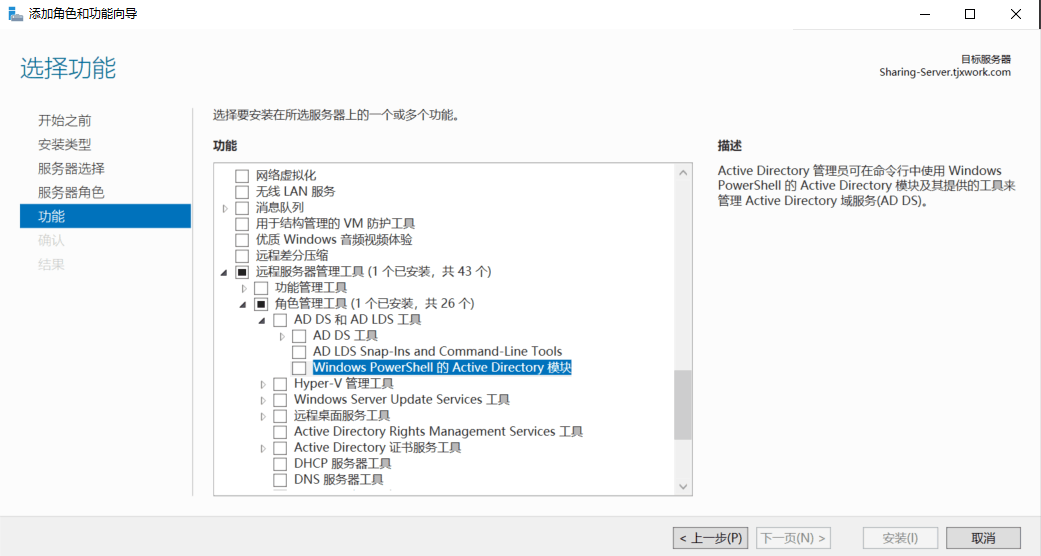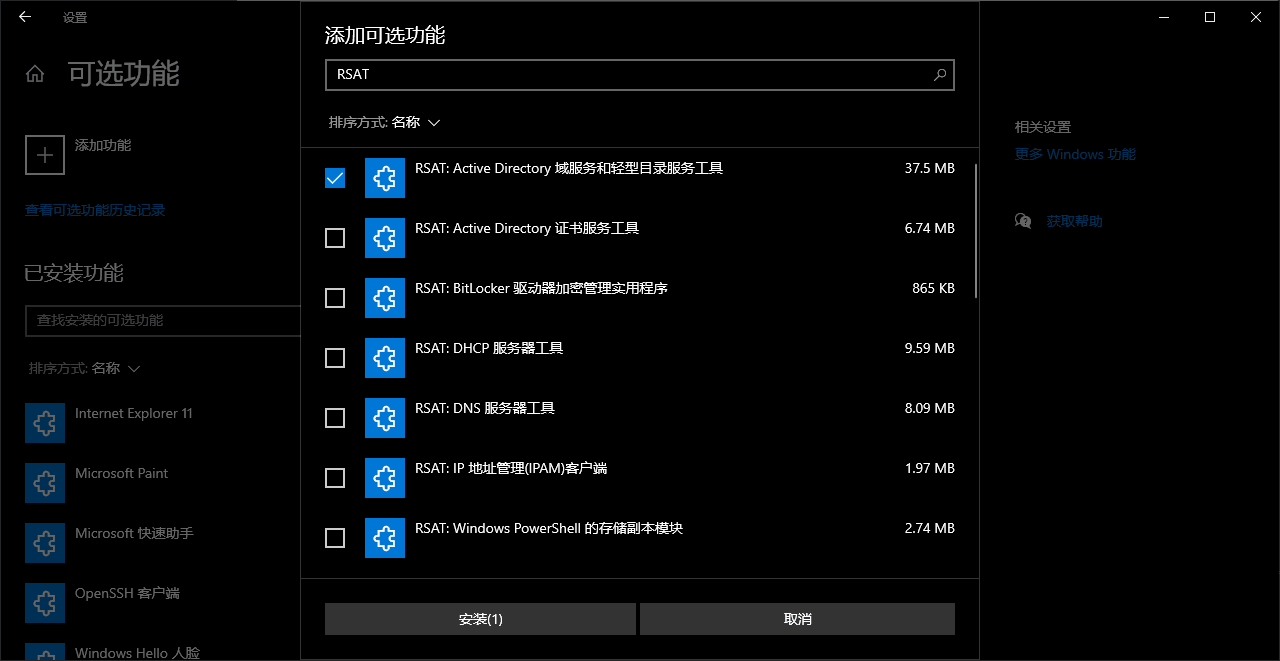准备
假设人事部给了你一份Excel表,记录了工号、姓名、部门、职位、公司,要按这表在AD域控上面创建对应的用户。
你稍加处理过后另存成了csv,内容格式如下:
| 工号 | 姓名 | 部门 | 员工类型 | 公司 |
|---|---|---|---|---|
| 1001 | 赵一 | 管理层 | 老板 | 广州番禺加班有限公司 |
| 1002 | 钱二 | 管理层 | 总监 | 广州番禺加班有限公司 |
| 1003 | 孙三 | 管理层 | 经理 | 广州番禺加班有限公司 |
| 1004 | 李四 | 管理层 | 经理 | 广州番禺加班有限公司 |
| 1005 | 周五 | 管理层 | 经理 | 广州番禺加班有限公司 |
| 1006 | 吴六 | 行政部 | 主管 | 广州番禺加班有限公司 |
| 1007 | 郑七 | 行政部 | 员工 | 广州番禺加班有限公司 |
| 1008 | 王七加加 | 行政部 | 员工 | 广州番禺加班有限公司 |
| 1009 | 冯九 | 行政部 | 员工 | 广州番禺加班有限公司 |
| 1010 | 陈十 | 行政部 | 员工 | 广州番禺加班有限公司 |
| 1011 | 褚十一 | 账务部 | 主管 | 广州番禺加班有限公司 |
| 1012 | 卫十二 | 账务部 | 员工 | 广州番禺加班有限公司 |
| 1013 | 蒋十三 | 账务部 | 员工 | 广州番禺加班有限公司 |
| 1014 | 沈十四 | 账务部 | 员工 | 广州番禺加班有限公司 |
| 1015 | 韩十五 | 账务部 | 员工 | 广州番禺加班有限公司 |
| 1016 | 杨十六 | 销售部 | 主管 | 广州番禺加班有限公司 |
| 1017 | 朱十七 | 销售部 | 员工 | 广州番禺加班有限公司 |
| 1018 | 秦十八 | 销售部 | 员工 | 广州番禺加班有限公司 |
| 1019 | 尤十九 | 销售部 | 员工 | 广州番禺加班有限公司 |
| 1020 | 许二十 | 销售部 | 员工 | 广州番禺加班有限公司 |
| 1021 | 何二一 | 后勤部 | 主管 | 广州番禺加班有限公司 |
| 1022 | 吕二二 | 后勤部 | 员工 | 广州番禺加班有限公司 |
| 1023 | 施二三 | 后勤部 | 员工 | 广州番禺加班有限公司 |
| 1024 | 张二四 | 后勤部 | 员工 | 广州番禺加班有限公司 |
| 1025 | 孔二五 | 后勤部 | 员工 | 广州番禺加班有限公司 |
| 1026 | 曹二六 | 技术部 | 主管 | 广州番禺加班有限公司 |
| 1027 | 严二七 | 技术部 | 员工 | 广州番禺加班有限公司 |
| 1028 | 华二八 | 技术部 | 员工 | 广州番禺加班有限公司 |
| 1029 | 金二九 | 技术部 | 员工 | 广州番禺加班有限公司 |
| 1030 | 魏三十 | 技术部 | 员工 | 广州番禺加班有限公司 |
需求
域账号需求:
域控的层级结构为:公司>部门>员工
以工号来当登陆名,初始密码和工号一样,首次后登陆后必须更改密码。
共享文件夹需求:
文件结构为: \\服务器\公司$\部门\员工
权限要求为:
老板、总监可以查看所有部门
部门之间不可互相查看
员工之间不可互相查看
员工对自己的文件夹可以读写
部门内有一个“部门共享”文件夹,部门内所有员工都可以读写
主管可以查看自己的整个部门所有员工的文件夹
所需命令
简单说明一下要用的命令
操作AD域要用的 Get-ADxxx、Set-ADxxx 这一类的命令要添加 Windows PowerShell 的 Active Directory 模块 才能使用。
添加了 Active Directory 域服务 的服务器,会自动加上去的,没有的话也能手动添加上去,没加域和没用对应的域权限运行是用不了的。
脚本里面的具体每条命令我就不解释了,自己去官网查一下吧,比我说得详细,用法实例结合参考我这里贴出来的命令。
服务器在 添加角色和功能向导 里面

Windows10就是在设置里面可选功能里面找

批量创建OU、组、用户
1# 根目录路径,批量在此路径下添加OU和用户,我这里直接用了域的根目录
2$OuRoot = Get-ADDomain | Select-Object -ExpandProperty "DistinguishedName"
3
4# 域名
5$DomainName = (Get-ADDomain).DNSRoot
6
7# 导入整理好的csv
8$UserList = Import-Csv "C:\Users\Administrator\Desktop\工号部门信息表.csv" -Encoding UTF8
9
10foreach ( $User in $UserList ) {
11
12 # 没有公司就创建公司
13 # 获取根目录OU下面的公司OU的DistinguishedName,拿不到就是没有
14 $OuRoot_Company = Get-ADOrganizationalUnit -Filter "Name -eq '$($User.公司)'" -SearchBase $OuRoot -SearchScope OneLevel | Select-Object -ExpandProperty "DistinguishedName"
15
16 if ( -Not $OuRoot_Company ) {
17 # 创建公司OU
18 New-ADOrganizationalUnit -Name $User.公司 -Path $OuRoot # -ProtectedFromAccidentalDeletion $False
19 # 获取公司OU 的DistinguishedName
20 $OuRoot_Company = Get-ADOrganizationalUnit -Filter "Name -eq '$($User.公司)'" -SearchBase $OuRoot -SearchScope OneLevel | Select-Object -ExpandProperty "DistinguishedName"
21 # 创建公司OU 的组
22 New-ADGroup -Name $User.公司 -Path $OuRoot_Company -GroupScope Global
23 }
24
25
26 # 公司下面没有部门就创建部门
27 # 获取公司下面的部门OU的DistinguishedName,拿不到就是没有
28 $OuRoot_Company_Department = Get-ADOrganizationalUnit -Filter "Name -eq '$($User.部门)'" -SearchBase $OuRoot_Company -SearchScope OneLevel | Select-Object -ExpandProperty "DistinguishedName"
29
30 if ( -Not $OuRoot_Company_Department ) {
31 # 创建公司下的部门OU
32 New-ADOrganizationalUnit -Name $User.部门 -Path $OuRoot_Company # -ProtectedFromAccidentalDeletion $False
33 # 获取公司下的部门OU 的DistinguishedName
34 $OuRoot_Company_Department = Get-ADOrganizationalUnit -Filter "Name -eq '$($User.部门)'" -SearchBase $OuRoot_Company -SearchScope OneLevel | Select-Object -ExpandProperty "DistinguishedName"
35 # 创建公司下的部门OU 的组,为什么这里要用“公司_部门”?因为可能有两个子公司,两个子公司都有财务部,只有一个公司可以去掉公司前缀
36 New-ADGroup -Name $($($User.公司) + "_" + $($User.部门) ) -Path $OuRoot_Company_Department -GroupScope Global
37 }
38
39
40 # 创建用户,相关属性自行增减,这里为了登陆的时候直接使用工号当账号密码,域服务器的本地组策略的密码复杂度是关掉的了。
41 New-ADUser `
42 -Name $User.姓名 `
43 -DisplayName $User.姓名 `
44 -EmployeeNumber $User.工号 `
45 -SamAccountName $User.工号 `
46 -UserPrincipalName "$($User.工号)@$DomainName" `
47 -Department $User.部门 `
48 -OtherAttributes @{EmployeeType=$($User.员工类型)} `
49 -AccountPassword $(ConvertTo-SecureString $User.工号 -AsPlainText -Force) `
50 -ChangePasswordAtLogon $True `
51 -Enabled $True `
52 -Path $OuRoot_Company_Department
53
54 # 获取用户的 DistinguishedName
55 $User_DN = Get-ADUser -identity $User.工号 | Select-Object -ExpandProperty "DistinguishedName"
56
57 # 把用户添加进公司_部门的组
58 $Company_Department_Group_DN = Get-ADGroup -identity $($($User.公司) + "_" + $($User.部门) ) | Select-Object -ExpandProperty "DistinguishedName"
59 Add-ADGroupMember -Identity $Company_Department_Group_DN -Members $User_DN
60
61 # 把部门添加进公司的组
62 $Company_Group_DN = Get-ADGroup -identity $User.公司 | Select-Object -ExpandProperty "DistinguishedName"
63 Add-ADGroupMember -Identity $Company_Group_DN -Members $Company_Department_Group_DN
64
65}批量创建共享文件夹
因为要拿AD域里面的信息,又懒得在文件共享服务器那边装模块(模拟可能的实际场景),所以这里用的是远程PowerShell命令
关于PowerShell设置文件权限的信息,可以看我的另一篇文章:
1# 要远程的共享文件服务器的名字(已加域)
2$InvokeServerName = "SHARING-SERVER"
3
4# 要在共享服务器上面的创建的共享文件夹的路径
5$SharedFolderPath = "D:\Shares\广州番禺加班有限公司"
6
7# 获取域
8$Domain = (Get-ADDomain).Name
9
10# 获取公司 OU
11$Company_OU = Get-ADOrganizationalUnit -Filter "Name -eq '广州番禺加班有限公司'"
12
13# 获取公司 组
14$Company_Group = Get-ADGroup -Filter * -SearchBase $Company_OU -SearchScope OneLevel
15
16# 获取公司下面的所有部门
17$Department_OU_List = Get-ADOrganizationalUnit -Filter * -SearchBase $Company_OU | Where-Object {$_.Name -ne "广州番禺加班有限公司"}
18
19# 获取公司下所有员工属性为老板和总监的员工
20$Boss_User_List = Get-ADUser -Filter "(employeeType -eq '老板') -or ( employeeType -eq '总监')" -SearchBase $Company_OU
21
22
23# 创建最顶层共享文件夹
24$InvokeScriptBlock1 = {
25 # 新建公司共享文件夹路径
26 New-Item -Path "$Using:SharedFolderPath" -ItemType Directory
27
28 # 设置公司共享文件夹,隐藏共享,共享路径是 \\服务器\GZ$
29 New-SmbShare -Name "GZ$" -Path "$Using:SharedFolderPath" -FullAccess "$Using:Domain\$($Using:Company_Group.Name)"
30
31 # 准备修改文件夹权限
32 $FolderPath = $Using:SharedFolderPath
33 $FolderAcl = Get-Acl -Path $FolderPath
34
35 # 设置 域 Administrator 的权限
36 $AccessRule = New-Object -TypeName System.Security.AccessControl.FileSystemAccessRule("$Using:Domain\administrator", "FullControl", "ContainerInherit,ObjectInherit", "None", "Allow")
37 $FolderAcl.SetAccessRule($AccessRule)
38
39 # 设置 公司 组的权限
40 $AccessRule = New-Object -TypeName System.Security.AccessControl.FileSystemAccessRule("$Using:Domain\$($Using:Company_Group.Name)", "ListDirectory", "None", "None", "Allow")
41 $FolderAcl.SetAccessRule($AccessRule)
42
43 # 设置 老板、总监的权限
44 if( ($Using:Boss_User_List.SamAccountName).Count -gt 0 ){
45 foreach ($Boss_User in $Using:Boss_User_List){
46 $AccessRule = New-Object -TypeName System.Security.AccessControl.FileSystemAccessRule("$Using:Domain\$($Boss_User.SamAccountName)", "Read", "ContainerInherit,ObjectInherit", "None", "Allow")
47 $FolderAcl.SetAccessRule($AccessRule)
48 }
49 }
50
51 # 禁用继承权限
52 $FolderAcl.SetAccessRuleProtection($true,$false)
53
54 # 应用到文件夹
55 Set-Acl -Path $FolderPath -AclObject $FolderAcl
56}
57
58Invoke-Command -ComputerName $InvokeServerName -ScriptBlock $InvokeScriptBlock1
59
60
61
62# 以部门进行循环
63foreach ($Department_OU in $Department_OU_List) {
64
65 # 获取部门下的所有用户
66 $Department_User_List = Get-ADUser -Filter * -SearchBase $Department_OU
67
68 # 获取部门下所有员工属性为主管的员工
69 $Director_User_List = Get-ADUser -Filter "employeeType -eq '主管'" -SearchBase $Department_OU
70
71 # 远程执行的代码块2
72 $InvokeScriptBlock2 = {
73
74 # 新建部门文件夹
75 New-Item -Path "$Using:SharedFolderPath\$($Using:Department_OU.Name)" -ItemType Directory
76
77 # 准备修改文件夹权限
78 $FolderPath1 = "$Using:SharedFolderPath\$($Using:Department_OU.Name)"
79 $FolderAcl = Get-Acl -Path $FolderPath1
80
81 # 设置 部门 组的权限
82 $AccessRule = New-Object -TypeName System.Security.AccessControl.FileSystemAccessRule("$Using:Domain\$($Using:Company_OU.Name)_$($Using:Department_OU.Name)", "ListDirectory", "None", "None", "Allow")
83 $FolderAcl.SetAccessRule($AccessRule)
84
85 if( ($Using:Director_User_List.SamAccountName).Count -gt 0 ){
86 # 设置 主管的权限
87 foreach ($Director_User in $Using:Director_User_List){
88 $AccessRule = New-Object -TypeName System.Security.AccessControl.FileSystemAccessRule("$Using:Domain\$($Director_User.SamAccountName)", "Read", "ContainerInherit,ObjectInherit", "None", "Allow")
89 $FolderAcl.SetAccessRule($AccessRule)
90 }
91 }
92
93 # 应用到文件夹
94 Set-Acl -Path $FolderPath1 -AclObject $FolderAcl
95
96 # 新建部门内“部门共享”文件夹
97 New-Item -Path "$Using:SharedFolderPath\$($Using:Department_OU.Name)\部门共享" -ItemType Directory
98
99 # 准备修改文件夹权限
100 $FolderPath2 = "$Using:SharedFolderPath\$($Using:Department_OU.Name)\部门共享"
101 $FolderAcl = Get-Acl -Path $FolderPath2
102
103 # 设置 部门\部门共享 组的权限
104 $AccessRule = New-Object -TypeName System.Security.AccessControl.FileSystemAccessRule("$Using:Domain\$($Using:Company_OU.Name)_$($Using:Department_OU.Name)", "Modify,ReadAndExecute,Write", "ContainerInherit,ObjectInherit", "None", "Allow")
105 $FolderAcl.SetAccessRule($AccessRule)
106
107 # 应用到文件夹
108 Set-Acl -Path $FolderPath2 -AclObject $FolderAcl
109
110 # 循环创建用户文件夹
111 foreach ($Department_User in $Using:Department_User_List ) {
112
113 # 新建用户文件夹
114 New-Item -Path "$Using:SharedFolderPath\$($Using:Department_OU.Name)\$($Department_User.Name)" -ItemType Directory
115
116 # 准备修改文件夹权限
117 $FolderPath3 = "$Using:SharedFolderPath\$($Using:Department_OU.Name)\$($Department_User.Name)"
118 $FolderAcl = Get-Acl -Path $FolderPath3
119
120 # 设置用户权限
121 $AccessRule = New-Object -TypeName System.Security.AccessControl.FileSystemAccessRule("$Using:Domain\$($Department_User.SamAccountName)", "Modify,ReadAndExecute,Write", "ContainerInherit,ObjectInherit", "None", "Allow")
122 $FolderAcl.SetAccessRule($AccessRule)
123
124 # 应用到文件夹
125 Set-Acl -Path $FolderPath3 -AclObject $FolderAcl
126
127 }
128 }
129
130 Invoke-Command -ComputerName $InvokeServerName -ScriptBlock $InvokeScriptBlock2
131
132}个人不太建议写长脚本的,测试修改起来挺麻烦的,宁愿拆分开多操作几次。
原文作者:tjxwork
原文链接:https://www.tjxblog.com/blog/2023-0006
发布时间:2023-02-16
评论